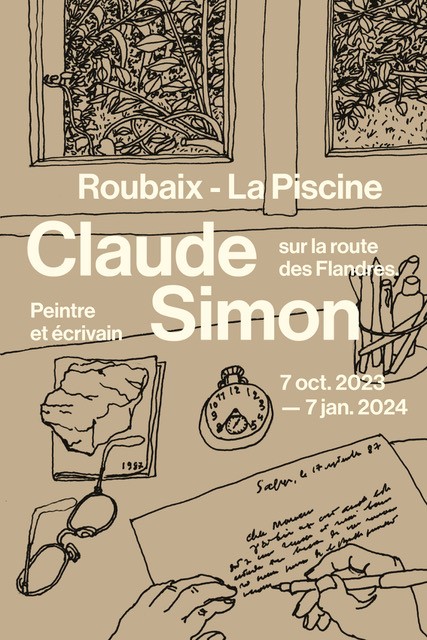Claude Simon on the Road to Flanders: The Painter and Writer
Exhibition from 7 October 2023 to 7 January 2024
“The dark purple shades beside the barite greens, the blacks of the trees behind the last brushwood and yellow ochre leaves” (notebook, 29 October 1939), “the bushy pale mauve woods” (December 23), “the purple shadow like that which falls from the stained glass windows of a crypt” (12 October).
1939. Claude Simon, who enlisted on 27 August, saw action in the war in Flanders where his cavalry regiment of the 31st Dragoons was sent as soon as the Second World War was declared. He soon became one of the few survivors of his squadron that fell into an ambush, and roamed on horseback along the deadly road to Flanders where his colonel was shot dead in front of him. He was taken prisoner in Germany, escaped and supported the Resistance until the Liberation.
He had just turned 26 in the army. A painter and photographer dividing up his time between Paris and Collioure, he began writing a first novel to be interrupted by the events of the time, and it was as a colourist that he eagerly noted the dazzling impressions that shaped his existence, like the strokes of a painting, in his “war journals”.
“Look! Look! » : in moments of extreme danger, it was the emotional resources contained in feelings that aided Claude Simon on his way through life. Along with his artistic genius.
From then on, the tragedy experienced in Flanders, that shattered every certainty, permeated all his work. While pursuing his painting, drawing, collage and assemblage work, where the plasticity of the colours and shapes gives free rein to representation techniques, Claude Simon searched for 20 years for the narrative form that could recount the disaster – the end of a world. An end of the world. The Flanders Road, a novel published in 1960, was his first masterpiece.
The writer took lessons in painting and developed a narrative based on the aesthetics of fragmentation and the study of harmonics, with an inclination towards compositional processes involving detached paintings, analogies and variations, partitions, with repentance and repetitions. The visual artist was replaced by the writer who, from that moment on, only wrote masterpieces, to be crowned with the Nobel Prize for Literature (1985).
La Piscine, André Diligent Museum of Art and Industry, in Roubaix offers a sumptuous panorama of the works of the visual artist Claude Simon, some of which have been recently discovered and are being exhibited for the first time. The paintings spread over various private collections have been gathered together; notebooks of drawings and preparatory sketches; certain analogue photographs of intimate scenes or composite objects that were printed by the author himself; the sequenced display of Album d’un amateur where there is a connection between the text and the images; the assemblages of paper cut out on screens which were part of the furniture in Claude Simon’s house, and his collages which are accompanied by the collages of those who inspired them: his friend Jacques Prévert; his second wife, painter and sculptor, Yvonne Ducuing.
Mireille Calle-Gruber
Scientific Committee
Mireille Calle-Gruber, writer and professor of literature and aesthetics at La Sorbonne Nouvelle
General Committee
At La Piscine museum in Roubaix: Pauline Dubouclez
At the Marguerite Yourcenar villa: Marianne Petit, director of Villa Yourcenar
At Château Coquelle: Paul Leroux, director of Château Coquelle
Key: Claude Simon (1913-2005) Untitled. Around 1963. Paper glued to newspaper. Special collection Photo: Alain Leprince



